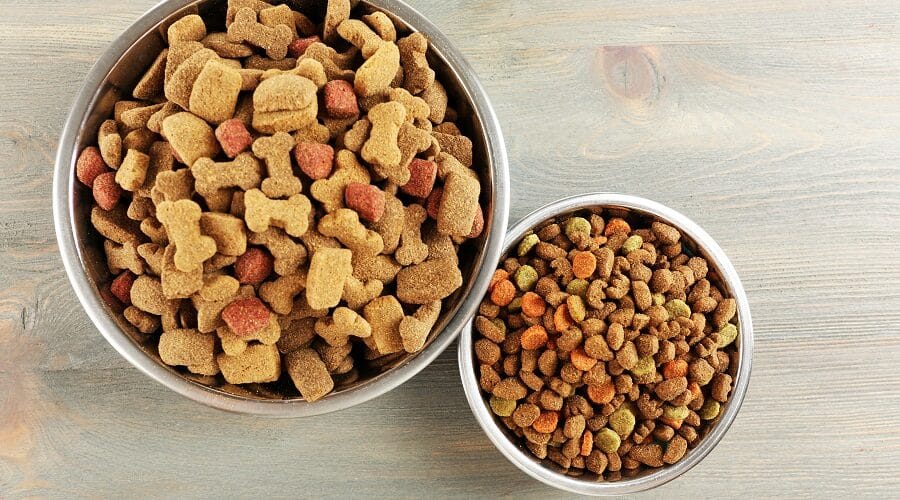Are you comparing Blue Buffalo vs. Wellness for your pup’s nutritional needs? The six essential nutrients that a dog needs are water, proteins, fats, carbohydrates, minerals, and vitamins. They are essential in your dog’s daily diet to assist all his core bodily functions.
The problem comes when you must face dozens of food choices claiming to be the best choice for your beloved pooch. Two of the most commonly researched brands are Blue Buffalo and Wellness. Both brands have a wide variety of dog food options for your pup, and compare each of these in detail based on your dog’s life stage.
No matter what age your dog is, your goal should be to feed them the best quality nutrition you can comfortably afford. While they aren’t cheaper dog food brands by any means, they are both reasonably affordable and have various flavors for your pup. Let’s take a look at each brand, Blue Buffalo vs. Wellness, in more detail.
Foods Comparison At A Glance: Wellness vs. Blue Buffalo
- Blue Buffalo Small Breed: Small Breed Grain-Free Chicken & Peas
- Wellness Small Breed: Complete Health Small Breed Recipe
- Blue Buffalo Medium Breed: Grain-Free Chicken & Peas
- Wellness Medium Breed: Complete Health Chicken & Oatmeal
- Blue Buffalo Large Breed: Large Breed Grain-Free Chicken & Peas
- Wellness Large Breed: Complete Health Large Breed Recipe
Note: Clicking the above links will take you to Amazon.com, where you can get additional product information and customer reviews. If you make a purchase, we earn a commission at no additional cost to you.
Comparing Brand Histories

Before you can really know which food is best for your dog, we need to take a look at the history of each brand. It’s good to know the history of any company that makes food your pup will ingest. You want to make sure they are committed to the health of your dog, just like you are.
Both Wellness and Blue Buffalo are newer brands, but both are well-known and reputable food manufacturers. Wellness has many different foods that we like, specifically their weight management formula, which is good for smaller breeds like Yorkies. Blue Buffalo, on the other hand, has historically made many different types of food ranging from one of the top formulas for older dogs, as well as higher fiber content dog food for pups that need help staying regular.
Wellness History
Wellness Pet Food is one of the youngest brands in the pet food industry, having been around for just over twenty years. It was launched in 1997 by a team of animal nutrition experts, veterinarians, and food scientists who set out to create the best natural pet food recipes possible. Using only the finest ingredients to promote good health and well-being and maintain their energy, they promised that artificial flavors, preservatives, and other chemicals would never included in their foods.
Wellness released its first recipes for dogs in 1997, followed by cat recipes in 2000. Manufacturing is all done in their own plant based in Mishawaka, Indiana. Wellness recipes are now available across the world.
Blue Buffalo History
Blue Buffalo is another relatively new company that was developed in Wilton, Connecticut, in 2012. The Bishop family was inspired by the early passing of their beloved family pooch “Blue.” who lost his battle with cancer. The family, in conjunction with a leading veterinarian and animal nutritionist, decided to develop nutritious dog food that could be beneficial for many health issues. By using natural ingredients such as real meat, their belief is that a healthy, balanced diet is key in managing and easing prominent health problems in pets.
The brand’s mission statement is, “Love them like family, feed them like family,” and it is still at the core of everything they do today. They promise not to compromise on quality or safety and offer a vast array of recipes that all start with real meat as the first ingredient. This ethos has seen them quickly become a very popular brand among dog owners. Blue Buffalo is one of the most commonly reviewed dog food brands, often being matched against brands like Nutro or compared to Merrick.
Nutritional Value Comparison
The best commonly accepted advice about feeding your furry friend is quite simply to feed him the best food that you can afford. The challenge here though is that the differences between good and bad food are not immediately obvious when looking at the product labels and nutritional content. It is more about the ingredients and their quality. Two foods may state 27% protein but comprise very different protein sources.
The easiest way to see the difference in the quality of the ingredients is to look at the first five ingredients listed, and if you recognize them as regular whole-food ingredients, that’s a great start. The pet food market is large and well-regulated, but you still need to do your own research. The better ones will have a reputable history and often have recipes based on scientific research and analysis, but again, if you are in any doubt about which is best for your pooch, ask your veterinarian for tailored advice.
The table below compares the average nutritional components of Wellness vs. Blue Buffalo’s most popular standard food for size specificity (see above for links to each product).
| Protein | ||||||
| Fats | ||||||
| Fiber | ||||||
| Kcal/Cup |
Protein, fat, and fiber are the three major components of food products that are measured. We have used these as the basis of our main nutrition comparison. Let’s look at why they are so important for your pup and how they compare with each brand.
Protein Content
Protein is important in a balanced canine diet as it is an integral part of building and repairing muscles and other body tissues. It helps form new skin cells, hair growth, build muscle tissue and assists in the creation of hormones and enzymes needed for everyday function. Our doggo buddies need 22 different amino acids to make the necessary proteins, of which they can only make about half naturally, and the rest comes from their food intake. So, it is essential that they are present in his food, as protein deficiencies can lead to health problems such as skin conditions, hormone imbalances, growth retardation, and even behavioral changes.
In this category, we can see a clear winner. Wellness has more protein in two of the products we looked at within their food for all sizes of pooch. The protein is also good quality, with deboned Turkey, Chicken meal, and Salmon meal listed as the first three ingredients, and no meat by-product is listed. Keep in mind that protein is less important for dogs like Dachshunds (small breeds) as they have smaller muscle quantities.
Fat Content
A common misconception leads people to immediately associate fat with obesity and being unhealthy, but this is not the case. Dogs require an essential intake of fat as part of a balanced diet, and as with an adult diet, there are good and bad fats. The good ones provide energy, as well as taste and flavor, and most importantly, assist with the absorption of certain vitamins.
Common fats used in dog foods are a positive addition to their nutrient intake, for example, Chicken or Pork fat, fish oil, and sunflower oil, to name just a few. The average adult dog requires somewhere between 10% and 15% of essential fats in their diet to stay healthy. Fat only becomes a problem when their intake increases and their exercise decreases, so go easy on the treats, and your pup will stay healthy.
We can see from the table that the only real difference in fat comes in the medium food comparison, where Wellness has 2% less and therefore has fewer calories, but this isn’t indicative of it being better as the Blue Buffalo food is still within the advised ratios and therefore still well balanced.
Fiber Content
Dietary fiber is basically the carbohydrate remnants of plant cells after digestion. Fiber absorbs water from outside of the colon into the dog’s stools and, therefore, aids in the prevention of diarrhea, promoting regular bowel movements. Fiber is a stool “stabilizer” that can often be the solution to any regular toilet problems your pooch has.
For dogs that need to lose weight, fiber is also helpful in reducing the food calorie content and helping your pup to feel fuller for longer. That way, they consume fewer calories but still feel like they have eaten the same amount.
We can see from the table that the fiber content is again very similar across the compared foods, but Blue Buffalo has a slightly higher fiber content in all three food types, so they win this round.
Flavors
If your pooch has finally become bored of a particular flavor, then there are a couple of easy ways to break up his boredom. Firstly, try adding a little warm water to dry kibbles as it creates a little bit of gravy, or mix a little wet food into the biscuits a couple of times a week.
If this doesn’t reignite his appetite, you can try a different recipe from the same brand range. While they won’t be too dissimilar, you will still need to transition him slowly to avoid stomach upset. Luckily, both Blue Buffalo and Wellness offer a reasonable choice of flavors to choose from, which should go some way to help your pooch stay interested in his tucker. So, the flavor round is a draw.
Cost
We all know that dog food prices can vary from super cheap to exorbitantly expensive, and while this can be affected by the size and energy level of your dog, much of it has to do with the type and quality of the food you choose. But buyer beware: expensive doesn’t always mean quality.
The key principle to buying right is to research and compare the products that suit your pooch and his individual dietary requirements and fall within your budget range. The below table offers a quick comparison of the average cost of both brands using the same kibbles noted above.
| Bag Size (Lbs.) | ||||||
| Average Cost/Lb. | ||||||
| Average Cost/Kcal |
On the face of it, it seems that Wellness is cheaper across all three products on a weight basis. but take a look at the cost per calorie, and you can see that Blue Buffalo is cheaper on two of the products. This is because the Wellness food does not provide the same amount of calories per standard cup. So, if the rest of the comparison factors in this guide are equal for you and your pup, and deciding between the two literally comes down to price, then Blue Buffalo would win here. This is common as Blue Buffalo frequently wins out against other brands like Science Diet and some bigger competitors.
Frequently Asked Questions
With most of the finer details covered in the above content, we still do get quite a few questions pertaining to each specific brand. In case we haven’t answered some that may come to mind, here are some of the questions you may still have:
Are these brands and products grain-free?
Both brands have grain-inclusive and grain-free recipes, and sometimes you have the choice of the same product. Be sure to read the descriptions carefully if you require grain-free food.
Do these brands use meat by-products?
In short, no. Both brands state that they avoid meat by-products in their recipes. However, Blue Buffalo has been legislated against misleading packaging in the past when their products were found to contain meat by-products. Since then, Blue Buffalo claims to have this issue resolved.
How do I know which brand is better for my dog?
This is a difficult question to answer without the specifics of what your pup needs. Both brands produce good quality food with different options for both size and lifestyle, so be sure to compare the products that fit your pup’s requirements, and if in doubt, seek advice from your local veterinarian team.
Pros & Cons
| Brand | Pros | Cons |
|---|---|---|
| Wellness | Quality natural ingredients | Lower than average calorie count |
| Grain free options | Not many different lifestyle offerings | |
| Good value for the money | Lack of flavor choice | |
| Blue Buffalo | Natural and Organic | Higher Average Price |
| Abundance of Recipes | Some Recipes Are Rich | |
| Brand Popularity |
Final Thoughts
Both companies are currently very popular for producing good quality, well-balanced food. Coupled with the impressive variety of ingredients that go into all their recipes, it makes this comparison a fairly close one. The ingredients used by both appear to place a lot of importance on meat as the first ingredient and use high protein meat meal as a quality ingredient, with recipes and formulas that cater to almost every kind of dog and individual needs.
It’s important to note that both brands are favorites of ours for different breeds for different reasons. For instance, we prefer Blue Buffalo as one of our top foods for Pitbull puppies, and Wellness has one of our favorite food formulas for a Siberian Husky. There is no one-size-fits-all, and you will ultimately have to decide what’s best for your pup through trial and error.
So, in order to make a decision as to who to recommend, we have to look at the overall offering from both brands. Because far more products are offered at a better average cost per calorie, Blue Buffalo takes the crown this time.






Hello, I have a Pug named Pugsley. I’m very confused by soooo many dog foods available. I would like to ask if you can help with a food that is the best for him, his breed? Also, is it best to give him food with by-products or No by-product’s? He will be 5 months old and I want to find a food that he can stay on throughout his life. On a side note, can you also recommend a dog food that could help with his anal glands, they are always being expressed? I would like your thoughts for foods to both questions. Thank you! I want to stay away from grain free as I have heard it’s bad for their heart.
Have German Shorthaired Pointers that are high energy and I have a hard time keeping weight on them,,, will either of these foods maintain their weight? Also have a new 10 week old GSP pup,, I want to make sure they have a great food. Is wellness puppy good for an active pup?
Each dog has their own health history that impacts weight gain. We’d recommend discussing each of these with your vet to determine the best option for your dog.
I have a Sheepadoodle puppy and was giving him Purina Pro Plan. I want to avoid by-products so thinking of changing to Wellness or Blue Buffalo but can’t really figure what’s best for my pup. My vet recommends Purina and Science Diet (they are sponsored). Please recommend which food you prefer. He is a large breed given the Old English Sheepdog in him.
Hi Alejandro – Blue Buffalo’s Wilderness line uses no by-products in their formulas. I’d start there if you are looking to move away from Purina Pro. Good luck with your pup!